Alabama has various beautiful birds, including brightly colored red birds. Commonly known as the Northern Cardinal, these birds are found throughout the Southeast United States and are one of the most popular birds in Alabama.
The Northern Cardinal is an easy-to-spot bird thanks to its vibrant red feathers, which can be seen flitting through the trees and bushes during the warmer months. Northern Cardinals live in various habitats, ranging from woodlands and forests to gardens and urban parks.
They can also be found in various open areas, fields, and meadows. Cardinals are known to be social birds and can often be seen in small groups or pairs. They are also quite vocal, making a variety of chirps and trills throughout the day.
These birds are an essential part of the Alabama ecosystem, providing food for other animals and helping to disperse seeds.
24 Red Birds in Alabama
The heart of the southeastern United States lies in Alabama, renowned for its rich cultural heritage, picturesque landscapes, and diverse wildlife.
Among its many natural treasures, Alabama boasts a remarkable avian population, captivating bird enthusiasts and scientists alike with its vibrant hues and melodious calls.
Here are 24 Red Birds in Alabama.
1. Northern Cardinal
The northern cardinal, a brightly colored songbird, is a common sight in many parts of North America. It is recognizable for its distinctive bright red plumage and black face mask.
It is also known by various other names, such as the redbird, common cardinal, red cardinal, or just cardinal. It is a bird in the genus Cardinalis, which comprises several North and South American cardinal species.
This species is mainly found in the eastern and southern parts of the United States and parts of Mexico and Canada. It prefers wooded areas and gardens and is known for its cheerful song.
It is a friendly bird that often lives in pairs or small flocks and can be seen foraging for food in open areas. The northern cardinal is an essential ecosystem member, as it helps disperse seeds and maintain healthy insect prey populations.
| Kingdom | Animalia |
| Phylum | Chordata |
| Class | Aves |
| Order | Passeriformes |
| Family | Cardinalidae |
| Genus | Cardinalis |
| Species | C. cardinalis |
2. House Finch
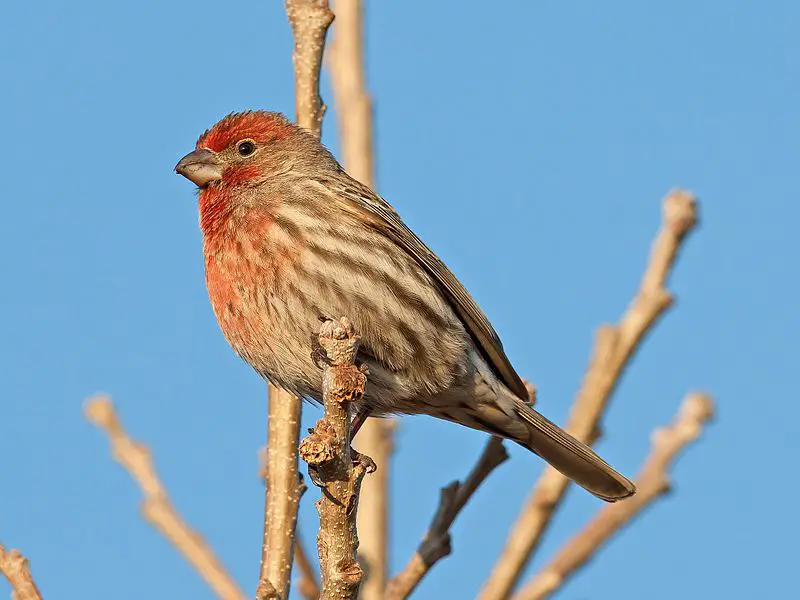
The house finch is a species of finch belonging to the Fringillidae family. This species is native to western North America but has been introduced to the eastern half of the continent and Hawaii.
The house finch is one of three species of American rosefinches placed within the genus Haemorhous. The other two species are the purple finch and the cassin’s finch.
These three species are known for their colorful plumage and ability to adapt to different environments and habitats. The house finch is quite common, and its range has expanded recently.
It is a seed-eating bird found in open areas such as gardens, parks, and agricultural fields. They often feed in flocks and are a familiar sight to many birdwatchers.
| Kingdom | Animalia |
| Phylum | Chordata |
| Class | Aves |
| Order | Passeriformes |
| Family | Fringillidae |
| Genus | Haemorhous |
| Species | H. mexicanus |
3. Summer Tanager
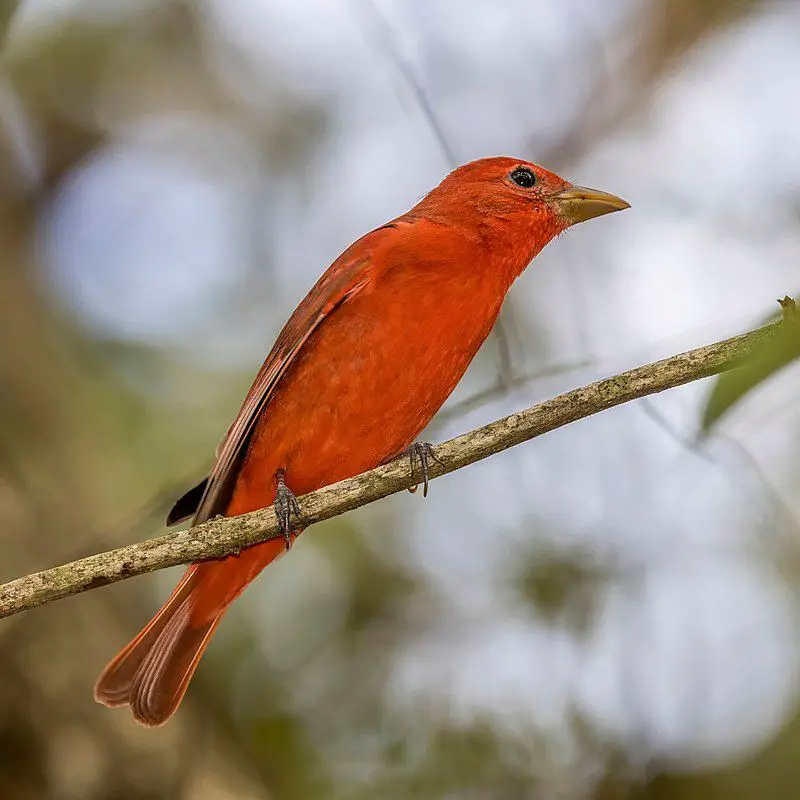
The summer tanager is a species of American songbird initially classified among the tanager family. However, recent taxonomic studies have revealed that the summer tanager and its genus are more closely related to the cardinal family.
This is evidenced by the similarity of the summer tanager’s plumage and vocalizations to those of other members of the cardinal family. The summer tanager’s plumage consists of a bright yellow body with wings and an orange or red tail.
Its call is a sharp chip, similar to many other cardinals. The summer tanager is a common sight in many parts of the United States, and its bright plumage makes it a favorite among birdwatchers.
| Kingdom | Animalia |
| Phylum | Chordata |
| Class | Aves |
| Order | Passeriformes |
| Family | Cardinalidae |
| Genus | Piranga |
| Species | P. rubra |
4. Red-Headed Woodpecker
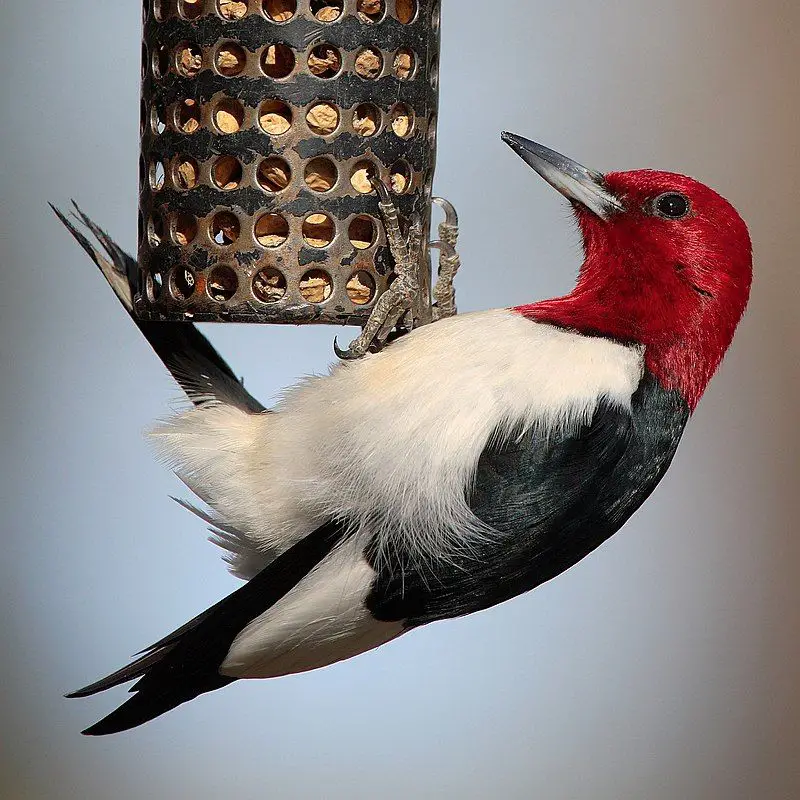
The red-headed woodpecker is a mid-sized bird in North America, specifically in temperate regions. It is a woodpecker species easily recognizable due to its distinctive red head.
Its breeding habitat is typically found in open country in southern Canada and the east-central United States. A migratory species often travel long distances for food and suitable nesting locations.
Its diet consists mainly of insects and nuts, and it is known to excavate cavities in trees to make its nest. It is a social species and can often be found in groups of up to a dozen individuals.
It is a common species, and its numbers have remained stable in recent years, however its population is still vulnerable to habitat destruction and other human-induced activities.
| Kingdom | Animalia |
| Phylum | Chordata |
| Class | Aves |
| Order | Piciformes |
| Family | Picidae |
| Genus | Melanerpes |
| Species | M. erythrocephalus |
5. Scarlet Tanager
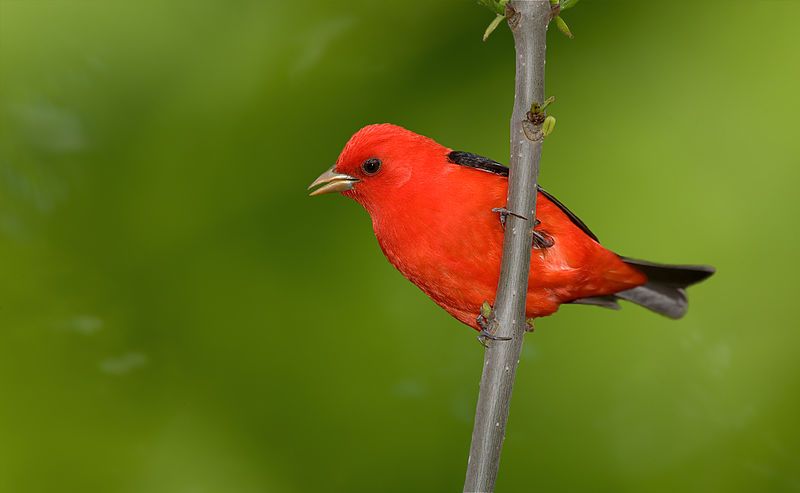
The scarlet tanager is a colorful bird that is found in North America. It is medium-sized, with males and females being approximately the same size.
Until recently, it was classified as a member of the tanager family, which includes a variety of tropical and subtropical birds.
However, recent studies have determined that the scarlet tanager and other members of its genus are more closely related to the cardinal family, which includes a variety of birds primarily found in the Americas.
As a result, the scarlet tanager has been reclassified and now belongs to the cardinal family.
This reclassification highlights the importance of continued research and study of bird species, as new information can often lead to changes in our understanding of the natural world.
| Kingdom | Animalia |
| Phylum | Chordata |
| Class | Aves |
| Order | Passeriformes |
| Family | Cardinalidae |
| Genus | Piranga |
| Species | P. olivacea |
6. American Robin
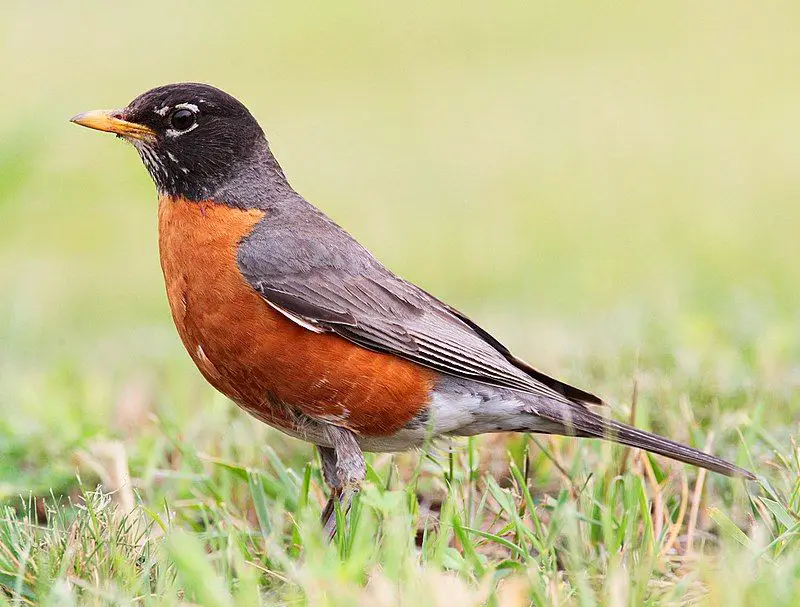
The American robin is a migratory bird of the Turdidae family, part of the wider thrush family. It is commonly known as the robin due to the reddish-orange breast on the bird, which is the same color as the European robin, though they are not closely related.
The American robin is part of the valid thrush genus, while the European robin is a member of the Old World flycatcher family. The American robin is one of North America’s most widely distributed birds and can be found in both urban and rural areas.
During the summer, they migrate northward to breed and can be found throughout much of the continent. They are one of North America’s most recognized and beloved songbirds, and their presence is a beloved sign of the changing seasons.
| Kingdom | Animalia |
| Phylum | Chordata |
| Class | Aves |
| Order | Passeriformes |
| Family | Turdidae |
| Genus | Turdus |
| Species | T. migratorius |
7. Rose-Breasted Grosbeak
The rose-breasted grosbeak is a large, seed-eating bird in the cardinal family. Commonly referred to as “cut-throat” due to its striking coloration, it is primarily a foliage gleaner.
Males of this species have an unmistakable color pattern, featuring a black head, wings, back, and tail, with a bright rose patch on its white breast. This colorful patch of color stands out against the otherwise dark plumage, making it unmistakable in the wild.
In addition to being a foliage gleaner, the rose-breasted grosbeak is also a frequent visitor to birdfeeders, where it will feed on sunflower and safflower seeds.
The rose-breasted grosbeak is a welcome sight to many birders, as it is a beautiful and colorful addition to any backyard.
| Kingdom | Animalia |
| Phylum | Chordata |
| Class | Aves |
| Order | Passeriformes |
| Family | Cardinalidae |
| Genus | Pheucticus |
| Species | P. ludovicianus |
8. Purple Finch
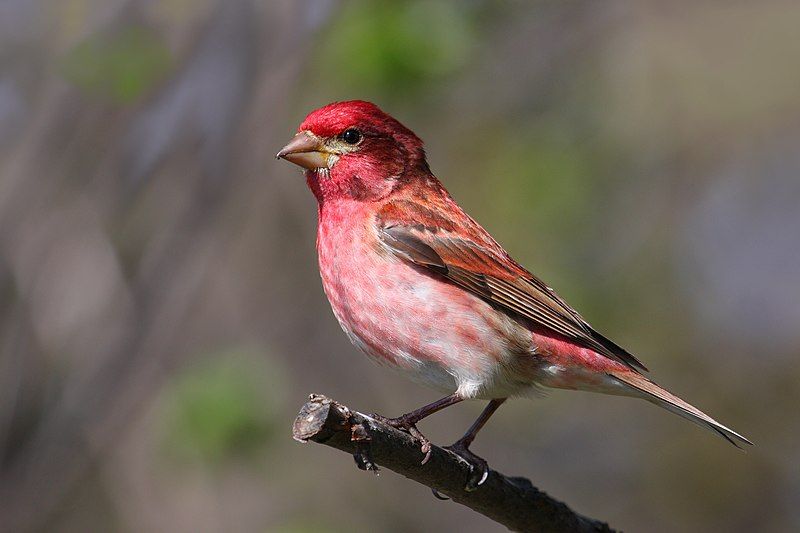
The purple finch is a species of bird that belongs to the Fringillidae family, commonly known as the finch family. This bird species is mainly found in the northern United States, southern Canada, and the west coast of North America.
It is a small bird with a length of 4.7-5.9 inches and a weight of about 0.5-0.9 ounces. The male purple finch has a dull purple-brown head, back, and chest, with white or yellowish underparts. The female is a more boring version of the male, with a brownish-streaked back.
The purple finch is often seen in flocks feeding on seeds and insects. They can also be found in open woodlands, gardens, and around bird feeders. The purple finch is a vital seed disperser, helping to spread the seeds of many shrubs and trees throughout its range.
It is also an important pollinator of many plants, helping to ensure their continued growth and survival.
| Kingdom | Animalia |
| Phylum | Chordata |
| Class | Aves |
| Order | Passeriformes |
| Family | Fringillidae |
| Genus | Haemorhous |
| Species | H. purpureus |
9. Ruby-Throated Hummingbird
The ruby-throated hummingbird is a species of hummingbird that is known for its impressive migratory pattern. It can be found in Central America, Mexico, and Florida during the winter months, where it enjoys a warm climate.
However, come summer, the ruby-throated hummingbird embarks on a long journey to Canada and other parts of Eastern North America. This migration allows the hummingbird to breed in the summer months, and it is an incredible feat of endurance and adaptability.
The ruby-throated hummingbird is an integral part of the ecosystem, and its annual migration is fascinating.
| Kingdom | Animalia |
| Phylum | Chordata |
| Class | Aves |
| Clade | Strisores |
| Order | Apodiformes |
| Family | Trochilidae |
| Genus | Archilochus |
| Species | A. colubris |
10. Red-Bellied Woodpecker
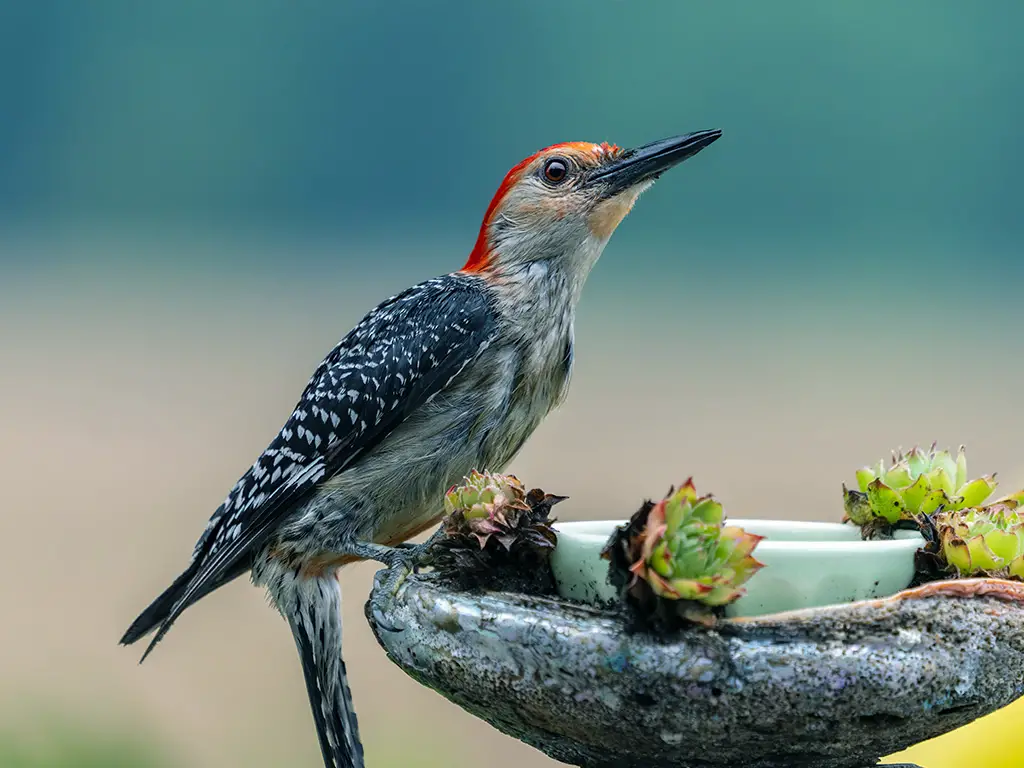
The Red-bellied Woodpecker is a medium-sized bird that belongs to the Picidae family. This woodpecker species is mainly found in the eastern United States but can be seen as far south as Florida and north as Canada.
It is a distinctive woodpecker with a bright red belly and a black and white back. It has a white line on its wings and a white eyestripe that gives it a unique look. The Red-bellied Woodpecker feeds on insects, nuts, fruits, and seeds.
It also stores food in tree cavities and crevices for later use. It makes its nest in the cavities of dead trees or old birdhouses.
The Red-bellied Woodpecker is an integral part of the ecosystem, helping to control insect populations and dispersing the seeds of trees and other plants. This woodpecker species plays an essential role in the health of forests and woodlands in the eastern United States.
| Kingdom | Animalia |
| Phylum | Chordata |
| Class | Aves |
| Order | Piciformes |
| Family | Picidae |
| Genus | Melanerpes |
| Species | M. carolinus |
11. Eastern Towhee

The eastern towhee is a large sparrow native to North America. It belongs to a group of birds called New World sparrows, which includes species like the American tree sparrow and white-crowned sparrow.
In recent decades, there has been debate surrounding the taxonomy of the eastern towhee.
Before his debate, this bird and the spotted towhee were considered the same species, the rufous-sided towhee. The eastern towhee’s breeding habitat consists of areas with thick brush in the eastern parts of North America.
It is an essential member of the avian community, as it offers shelter to other species and plays an integral role in the local ecology. Its presence in these areas helps to control the spread of pests and diseases, and it also helps to promote seed dispersal.
The eastern towhee is also an important food source for many other species, helping to maintain the balance of the local food web.
| Kingdom | Animalia |
| Phylum | Chordata |
| Class | Aves |
| Order | Passeriformes |
| Family | Passerellidae |
| Genus | Pipilo |
| Species | P. erythrophthalmus |
12. Northern Flicker
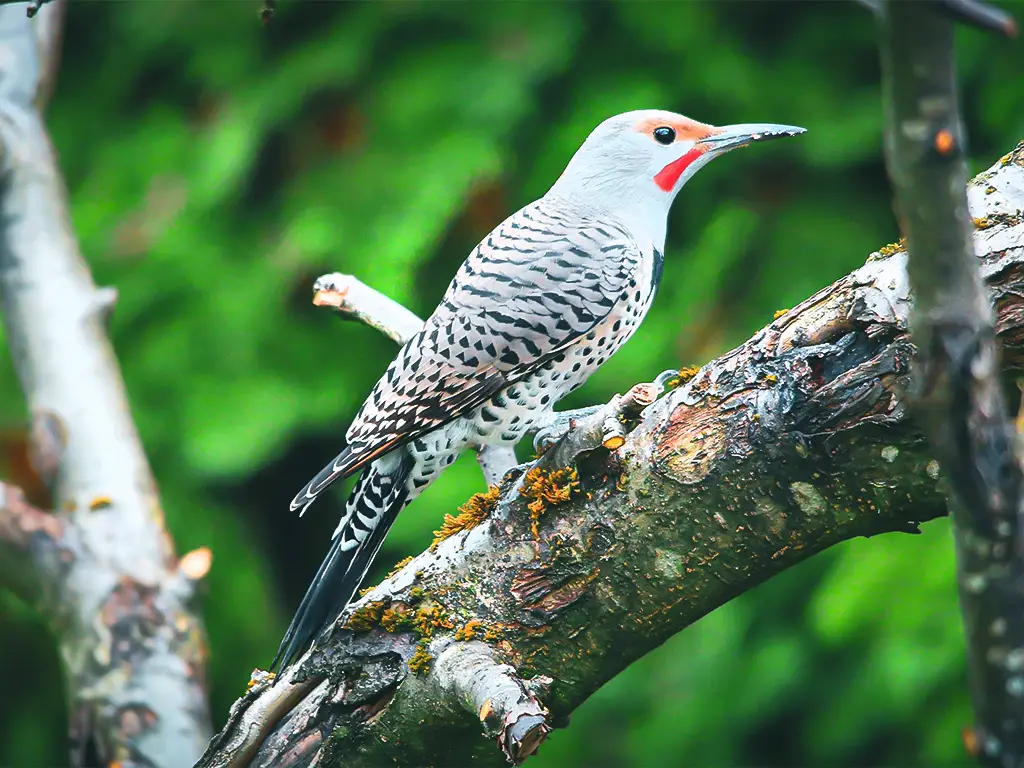
The Northern Flicker, also known as the Common Flicker, is a woodpecker species found throughout North America, Central America, Cuba, and the Cayman Islands.
This bird is medium-sized, with a length of 11-14 inches and a wingspan of 18-20 inches, and is easily identified by its gray-brown upper body feathers, black and white bars on its wings, and its red crescent on its neck.
It has a loud, distinctive call can often be heard throughout its range. The Northern Flicker is unique among woodpecker species, as it is one of the few that migrate.
This species is known to travel south in winter and return to its breeding grounds during spring and summer.
It is also known to forage in open areas, such as lawns, pastures, and roadsides, and is an essential species for controlling insect populations. In addition to its foraging habits, the Northern Flicker is known to create its nest in trees, cavities, and wooden buildings.
Its diet consists mainly of insects, as well as fruits and nuts. This species is a vital part of the North American ecology and is crucial in maintaining healthy forests and woodlands.
| Kingdom | Animalia |
| Phylum | Chordata |
| Class | Aves |
| Order | Piciformes |
| Family | Picidae |
| Genus | Colaptes |
| Species | C. auratus |
13. Red-Winged Blackbird
The red-winged blackbird is a beautiful passerine bird, easily identifiable by its bright red and yellow wings. It is a member of the Icteridae family, a group of birds known for their cheerful melodies and bold colors.
This particular species is found in most of North America and much of Central America, making it one of the most widespread bird species in these regions. Red-winged blackbirds are usually seen near large bodies of water, such as lakes, ponds, and marshes.
They can also be found in grasslands, wet meadows, and other open areas. Their diet consists of insects, seeds, and other invertebrates. They also eat small amounts of grain and other plant material.
Red-winged blackbirds gather in large flocks during the summer months and sing their complex, melodic songs. The males are incredibly vocal, attempting to attract a mate during this time.
Red-winged blackbirds are popular among birdwatchers, as they are easy to spot and photograph. They are an essential species in many ecosystems, providing food for other animals and helping to disperse seeds.
| Kingdom | Animalia |
| Phylum | Chordata |
| Class | Aves |
| Order | Passeriformes |
| Family | Icteridae |
| Genus | Agelaius |
| Species | A. phoeniceus |
14. Red-Shouldered Hawk
The red-shouldered hawk is a medium-sized bird known as a buteo. This particular species of hawk can be found throughout eastern North America, along the coast of California and parts of Mexico.
It is a permanent resident in most of its range, meaning it does not migrate, although some northern hawks migrate to central Mexico yearly. The red-shouldered hawk is a unique species with a wide range distributed across many areas.
They are a familiar sight across much of North America and have become a much-loved bird amongst bird watchers and wildlife enthusiasts alike.
| Class | Aves |
| Order | Accipitriformes |
| Family | Accipitridae |
| Genus | Buteo |
| Species | B. lineatus |
15. Downy Woodpecker
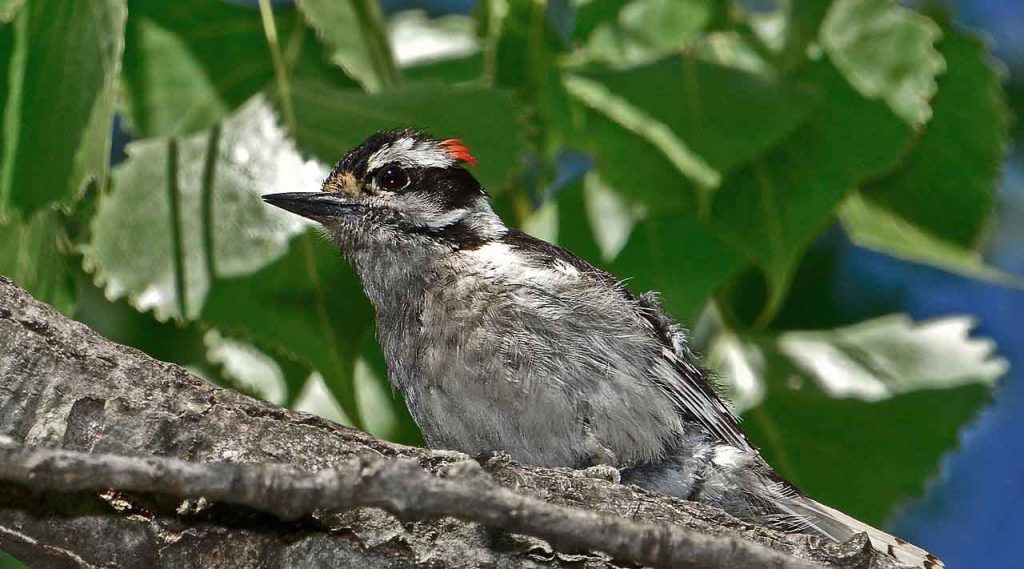
The Downy Woodpecker is a species of woodpecker found throughout North America, from the United States to Canada. It is the smallest woodpecker species in the region, typically measuring between 14 and 18 cm long.
They prefer to make their homes in forested areas, typically avoiding the deserts of the US Southwest and the northern tundra regions of Canada. Downy woodpeckers are common in backyards, parks, and woodlands throughout North America.
The red patch on their heads quickly identifies the males, while the females have blackheads. They feed primarily on insects but will also eat fruit and seeds. They are very vocal and often tap on tree trunks or branches.
The downy woodpecker is a fascinating bird; its presence is a welcome sight in many areas. It is an integral part of the North American ecosystem, helping to control insect populations and aiding in the dispersal of seeds.
Its bright colors and cheerful song make it a favorite among birdwatchers and nature lovers.
| Kingdom | Animalia |
| Phylum | Chordata |
| Class | Aves |
| Order | Piciformes |
| Family | Picidae |
| Genus | Dryobates |
| Species | D. pubescens |
16. Barn Swallow
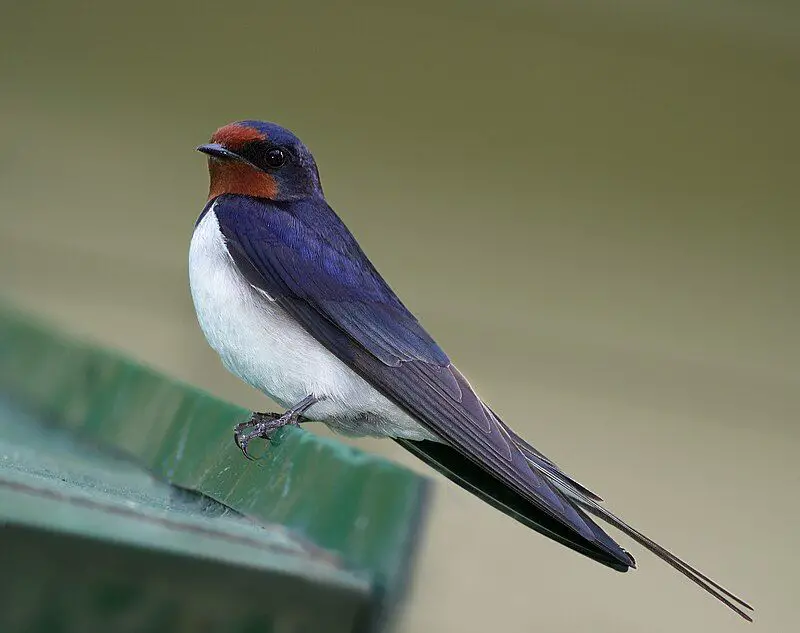
The barn swallow is a unique species of bird that is found all over the world. It is the most widespread swallow species and has the most extensive natural distribution of the world’s passerines.
This means that it can be found over 251 million square kilometers all around the globe. The barn swallow is a distinctive-looking bird with blue upperparts and a long, deeply forked tail. It has a wingspan of around 20 to 24 cm and a body length of around 16 to 19 cm.
Its bill is short and black, and its legs are short and fleshy. It is a social bird and usually lives in flocks of up to several hundred individuals. During the breeding season, they choose to nest in colonies consisting of up to a thousand birds.
They prefer to nest in cavities, like barns, bridges, and other artificial structures. The barn swallow is an insectivorous species, mainly feeding on flying insects, like flies, bees, wasps, and moths.
They usually forage during the day but can also hunt at night if the conditions are right.
They fly low and fast in pursuit of their prey, often swooping to the ground to snatch their food. The barn swallow is a genuinely fascinating species and can be found worldwide.
It is an integral part of the ecosystem, helping to control insect populations and providing food for other predators.
| Kingdom | Animalia |
| Phylum | Chordata |
| Class | Aves |
| Order | Passeriformes |
| Family | Hirundinidae |
| Genus | Hirundo |
| Species | H. rustica |
17. Red-Tailed Hawk
The red-tailed hawk is an impressive bird of prey that can be found across the continent of North America. It can be seen in areas from Alaska and Canada in the north down to Panama and the West Indies in the south.
It is a member of the genus Buteo, one of the most common birds in North America and worldwide. The red-tailed hawk has a wingspan of up to four feet, and its body is usually brown with a white chest.
Its most distinctive feature is its red tail, which gives it its name. They are versatile hunters that can feed on small mammals, reptiles, amphibians, and other birds.
They are also scavengers, taking advantage of carcasses left behind by other animals. The red-tailed hawk is an adaptable bird and can be found living in various habitats, from open grasslands and deserts to woodlands and forests.
They typically nest high in trees or on cliff ledges and can be seen soaring in the sky on the lookout for their next meal.
This bird of prey is an essential part of the North American ecosystem, helping to regulate small mammal populations and keep a healthy balance in the environment.
The red-tailed hawk is also a famous bird for birdwatchers, as they are easily recognizable and often visible in the sky.
| Kingdom | Animalia |
| Phylum | Chordata |
| Class | Aves |
| Order | Accipitriformes |
| Family | Accipitridae |
| Genus | Buteo |
| Species | B. jamaicensis |
18. Palm Warbler
The palm warbler is a bird species belonging to the New World warblers family. It is a small bird, typically measuring between five and six inches in length and weighing between nine and eleven grams.
Its plumage is a light brown with yellow and white streaks on the wings and tail. It has a short, thin bill and a white throat.
During the breeding season, the male palm warbler has an orange-buff-colored crown. The palm warbler is found across much of the United States and Canada and parts of northern Mexico. It is most commonly found in wet woodlands and marshes.
It migrates south in the winter, spending the colder months in areas from the southern United States to Central America and the Caribbean.
It can be seen in large flocks in open fields and along coasts during migration. The palm warbler is an insectivore, feeding mainly on insects, spiders, and occasionally small fruits. It forages on the ground and in low shrubs, often bobbing its tail as it searches for food.
Its song is a series of short, high-pitched notes. The palm warbler is not considered to be threatened. However, its population is declining in some areas due to habitat loss.
The species is also vulnerable to the effects of climate change, as warmer temperatures and changing weather patterns can cause a decrease in its insect prey.
| Kingdom | Animalia |
| Phylum | Chordata |
| Class | Aves |
| Order | Passeriformes |
| Family | Parulidae |
| Genus | Setophaga |
| Species | S. palmarum |
19. Yellow-Bellied Sapsucker
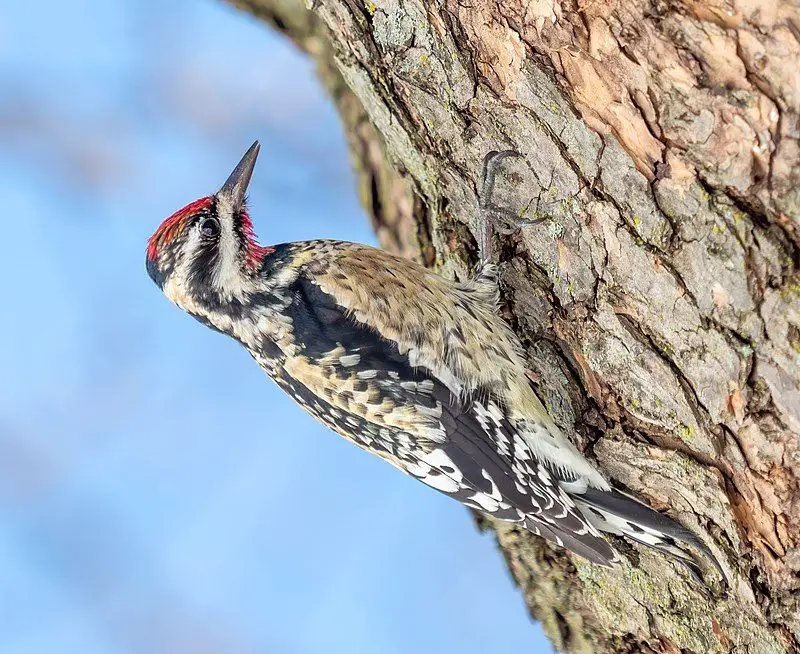
The yellow-bellied sapsucker is a species of woodpecker native to North America. It is a medium-sized bird, measuring 20-25 centimeters long and weighing between 40 and 50 grams.
The sapsucker has a distinctive appearance: a black head, a white spotted back, and a yellow belly. It also has a red crown and white stripes on its wings. The yellow-bellied sapsucker breeds in Canada and the northeastern United States, where it can be found in wooded areas.
In the warmer months, it can be seen drilling into tree trunks for sap, insects, and berries. It often forages on the ground, picking up fallen seeds, fruits, and nuts.
The yellow-bellied sapsucker typically nests in tree cavities but may also use pre-existing cavities in wooden buildings or telephone poles. Its diet consists of sap, insects, berries, and nuts.
This species is an integral part of the North American ecosystem, as it helps to disperse seeds and pollinate flowers. Its presence is also beneficial to other birds, as it may attract species such as flycatchers, warblers, and vireos.
| Kingdom | Animalia |
| Phylum | Chordata |
| Class | Aves |
| Order | Piciformes |
| Family | Picidae |
| Genus | Sphyrapicus |
| Species | S. varius |
20. Pileated Woodpecker
The pileated woodpecker is a large, black bird native to North America. It is easily identified by its size and distinct features, such as its black head, white stripes on the sides of its neck, and a large, red crest.
It is an insectivore, feeding mainly on insects found in deciduous forests in eastern North America, the Great Lakes, the boreal forests of Canada, and parts of the Pacific Coast.
The pileated woodpecker is an integral part of forest ecosystems because it helps clear dead trees of insects. Its drumming sounds can often be heard in forests, adding to its unique presence.
In addition, it is an important food source for various wildlife species, such as hawks and owls. It is also a sought-after species for bird watchers due to its exciting features and behaviors.
| Kingdom | Animalia |
| Phylum | Chordata |
| Class | Aves |
| Order | Piciformes |
| Family | Picidae |
| Genus | Dryocopus |
| Species | D. pileatus |
21. Carolina Wren
The Carolina wren is a species of wren native to the eastern half of the United States, as well as the southernmost regions of Ontario in Canada and the northeastern region of Mexico.
It is a common species of wren often seen in residential and suburban areas. They are known for their loud, musical trill, which they use to mark their territory and attract potential mates.
They have various habitats, ranging from marshlands to suburban backyards, and can be found in deciduous and coniferous forests. They build their nests in areas with dense vegetation or even in birdhouses and other artificial structures.
They are omnivorous, meaning they feed on insects and berries, and are considered an essential part of the local ecosystem as they help control insect populations.
| Kingdom | Animalia |
| Phylum | Chordata |
| Class | Aves |
| Order | Passeriformes |
| Family | Troglodytidae |
| Genus | Thryothorus |
| Species | T. ludovicianus |
22. Turkey Vulture
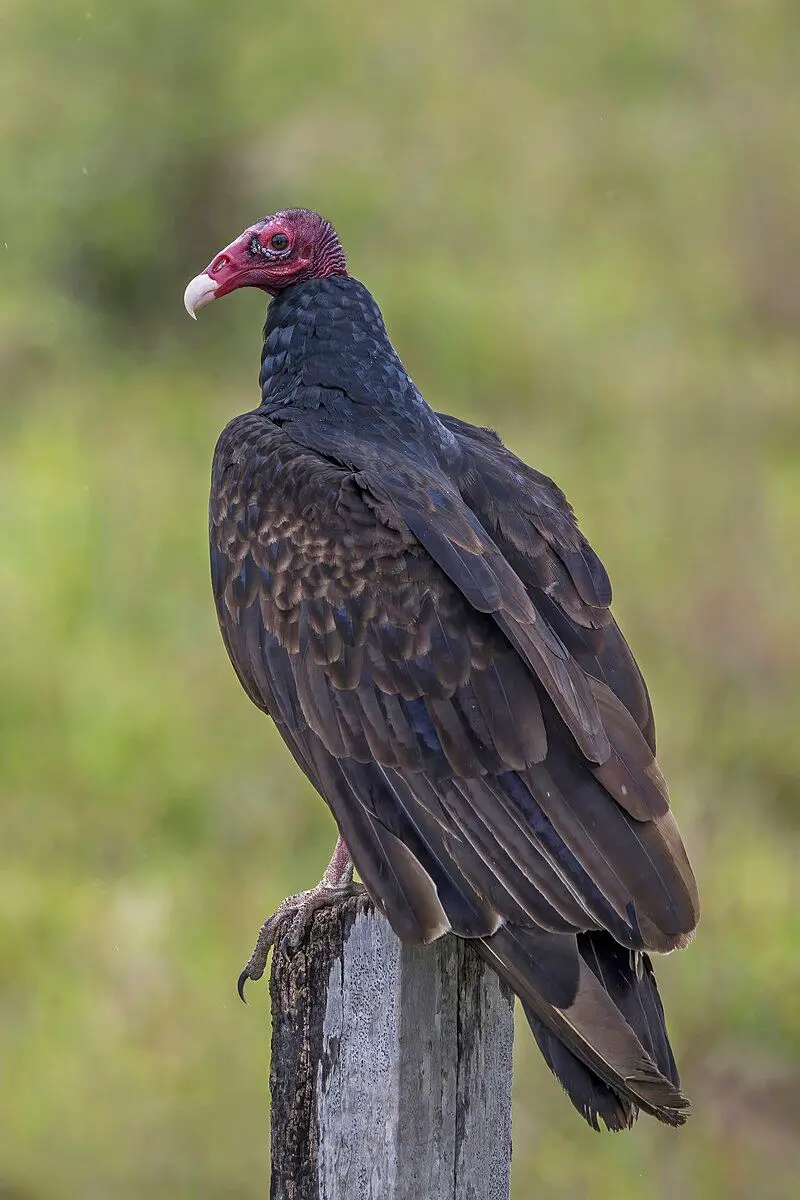
The turkey vulture is an essential member of the New World vultures, a group of scavenging birds throughout the Americas. It is the most widely distributed of the three species in the Cathartes genus, a part of the Cathartidae family.
These birds can be found in various habitats, from southern Canada to the southern tip of South America. Turkey vultures are unique among the New World vultures in that they have no feathers on their head, making them easily recognizable by their bald redheads.
They have long, broad wings, which they use to soar over the landscape for food. They feed mainly on carrion, such as dead animals, and rely on their keen sense of smell to locate their meals.
As scavengers, they play an essential role in keeping the environment clean by consuming animal carcasses and other organic material. In addition to their scavenging habits, turkey vultures also scavenge for food in garbage dumps, which helps to reduce pollution.
| Kingdom | Animalia |
| Phylum | Chordata |
| Class | Aves |
| Order | Accipitriformes |
| Family | Cathartidae |
| Genus | Cathartes |
| Species | C. aura |
23. Wood Duck
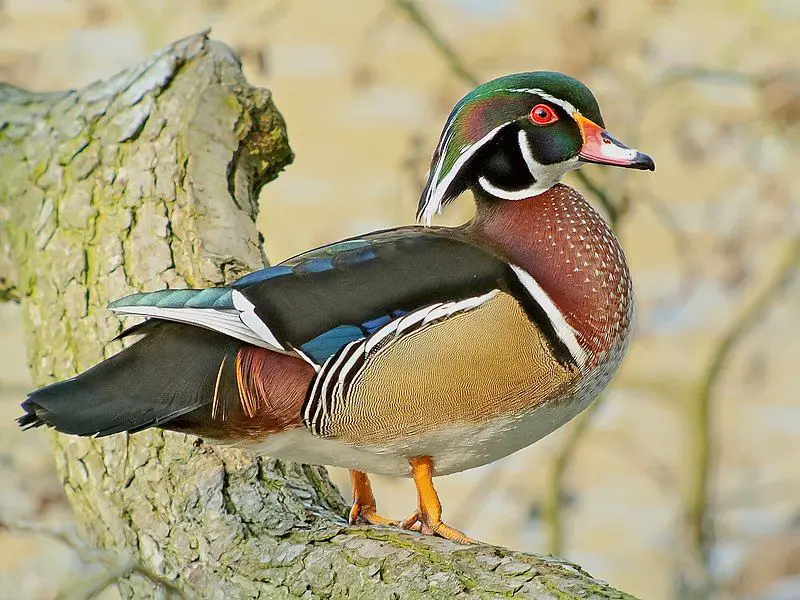
The wood duck, also known as the Carolina duck, is a unique species throughout North America. It is a perching duck, meaning it prefers to stay in trees or on logs while it searches for food.
The Drake wood duck is remarkably distinct, one of the most vibrantly colored waterfowl found in North America. It has a bright combination of colors, including iridescent blues, oranges, and whites, which makes it stand out among other species.
The male wood duck also has a beautiful crest of feathers atop its head, which adds to its already striking appearance. Its unique coloring and crest make it one of the most sought-after ducks by bird watchers and hunters alike.
| Kingdom | Animalia |
| Phylum | Chordata |
| Class | Aves |
| Order | Anseriformes |
| Family | Anatidae |
| Genus | Aix |
| Species | A. sponsa |
24. Laughing Gull
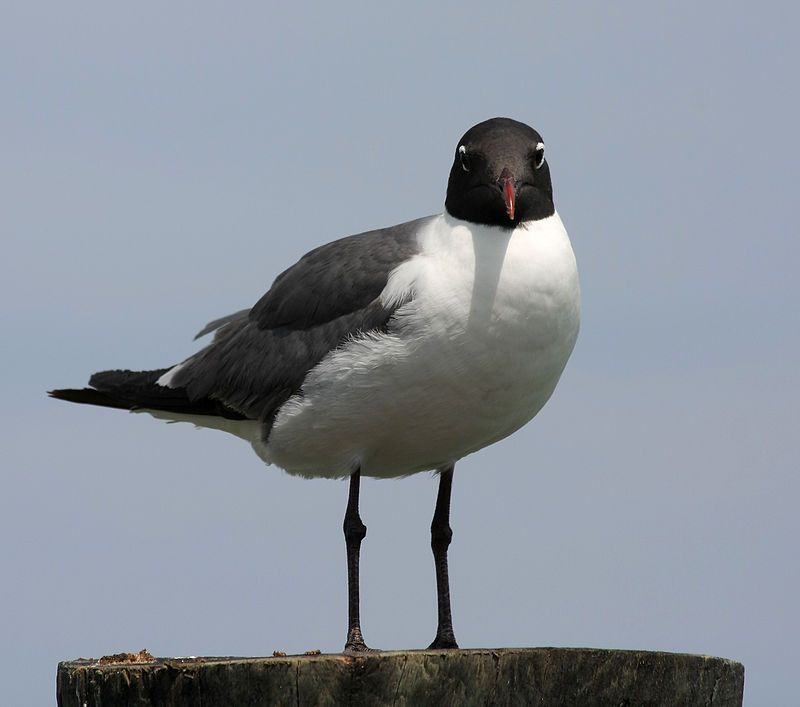
The Laughing Gull, scientific name Larus atricilla, is a medium-sized, white-headed gull native to North and South America. It is so named for its distinctive, laugh-like call, used to signal to other members of its flock.
These birds are opportunistic omnivores, meaning they feed on plant and animal matter and scavenging for carrion. They breed in large colonies, mainly along the Atlantic coast of North America, the Caribbean, and northern South America.
The two recognized subspecies of Laughing Gulls are Larus atricilla ridgwayi and Larus atricilla atricilla. Laughing Gulls are generally found near the coast but occasionally venture inland for food.
They are attracted to open, grassy areas near water, where they feed on insects, crabs, small fish, and other small animals. They also feed on garbage, carrion, and spilled grain.
During the breeding season, Laughing Gulls form large colonies, often in the company of other seabirds such as terns and skimmers. The nests are constructed from grass, twigs, and seaweed, and the female lays two to three eggs.
The parents take turns incubating the eggs, and the chicks will fledge in about five weeks. Laughing Gulls are social birds, and their populations are concentrated in coastal areas. They are also highly adaptable and have been known to live in urban areas near ports and cities.
They are not considered endangered, although their numbers have decreased in some areas due to habitat loss and human disturbance.
| Kingdom | Animalia |
| Phylum | Chordata |
| Class | Aves |
| Order | Charadriiformes |
| Family | Laridae |
| Genus | Leucophaeus |
| Species | L. atricilla |
Conclusion
Redbirds can be seen throughout Alabama, from the coastal regions in the south to the Appalachian Mountains in the north.
While they may not be as common as other bird species, their striking color and melodic songs make them a welcome sight for many birdwatchers. Redbirds are an integral part of Alabama’s wildlife and remind us of the beauty of the natural world.